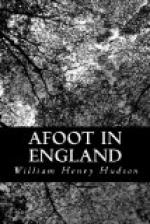Swallows, martins, and swifts were numerous, the martins especially, and it was beautiful to see them for ever wheeling about in a loose swarm about the building. They reminded me of bees and flies, and sometimes with a strong light on them they were like those small polished black and silvery-white beetles (Gyrinus) which we see in companies on the surface of pools and streams, perpetually gliding and whirling about in a sort of complicated dance. They looked very small at a height of a couple of hundred feet from the ground, and their smallness and numbers and lively and eccentric motions made them very insect-like.
The starlings and sparrows were in a small minority among the breeders, but including these there were seven species in all, and as far as I could make out numbered about three hundred and fifty birds—probably the largest wild bird colony on any building in England.
Nor could birds in all this land find a more beautiful building to nest on, unless I except Wells Cathedral solely on account of its west front, beloved of daws, and where their numerous black company have so fine an appearance. Wells has its west front; Salisbury, so vast in size, is yet a marvel of beauty in its entirety; and seeing it as I now did every day and wanting nothing better, I wondered at my want of enthusiasm on a previous visit. Still, to me, the bird company, the sight of their airy gambols and their various voices, from the deep human-like dove tone to the perpetual subdued rippling, running-water sound of the aerial martins, must always be a principal element in the beautiful effect. Nor do I know a building where Nature has done more in enhancing the loveliness of man’s work with her added colouring. The way too in which the colours are distributed is an example of Nature’s most perfect artistry; on the lower, heavier buttressed parts, where the darkest hues should be, we find the browns and rust-reds of the minute aerial alga, mixed with the greys of lichen, these darker stainings extending




